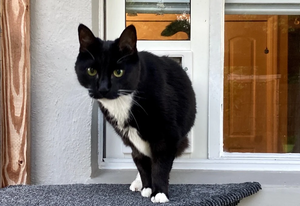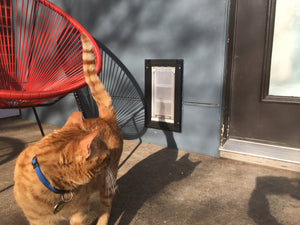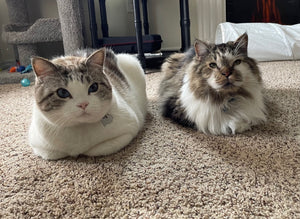How to Stop a Dog from Chasing Cats
Most dogs experience the urge to chase cats, especially breeds with strong drives to pursue what they consider as prey (aka: small animals). For other dog breeds, they are overcome with their desire to play, often wrongly assuming that cats love to play tag and roughhouse as much as any other canine. However innocent your dog’s intentions may be when chasing cats, the pursuit causes stress and fear for our feline friends. Similarly, it also poses a threat to the dog, as the cat may claw in defense. We don’t want any scratched eyes or noses!
It is best to start training for good behavior when your new dog is still a puppy if you have the chance, but we all know that this is not always the case. From adopting rescue dogs to introducing a cat into the family after your dog has reached adulthood, the opportunity is not always available. Regardless of the situation you are in, the following training tips are some of the most successful tactics for ensuring the safety and happiness of both cats and dogs. Remember that this is a multi-faceted approach that won’t change your dog’s high prey drive overnight, but is a process that takes time for growth and development.
If you do have a family cat in the house, then it is important to make sure that they have a safe place to go to when they are feeling stressed or need a time-out. Cat towers or smaller cat doors that lead outside or to a separate room are great safe areas for cats. This way, your dog is not always in the presence of the cat, and you cat has a place to escape to until your dog start exhibiting calm behavior.
For times with limited pet supervision, it is recommended to use a playpen, exercise pen, or other indoor enclosure to separate the dog and cat, making sure that your cat avoids any stressful situations and your dog does not have the opportunity to misbehave. This is especially important if you have a new puppy who has yet to see a certified professional dog trainer or another dog behaviorist.
Redirecting Behavior:
According to animal behavior consultants, one of the most prominent indicators of initiating a chase is staring. If your dog is intently staring at the cat, there is a pretty high chance that they want to bolt after the cat. Keep an eye out for staring, because stopping the process as early on as possible is crucial in long term behavioral change.
As soon as you catch your dog staring, or making any other initiative notions such as whining or growling, get their attention by clapping your hands, whistling, and/or calling your dog’s name. This will help divert the attention away from the cat and shift the focus towards you.
Upon your dog’s attention toward you, make sure to reward them with praise and even a delicious training treat. Positive reinforcement is more effective than discipline in these cases, because dogs are more likely to stick to behavior that produces rewarding outcomes.
“Leave It” - A Positive Reinforcement:
If your dog has had any obedience training in the past, the “leave it” trick can be one of the most beneficial voice commands to prevent chasing. This tactic involves a two-step process. First, begin training with a treat in each hand, preferably of different types. Let your dog smell one of your hands so that they know the treat is there, ready to be eaten. Ignore their attempts to get the treat, saying “leave it”, until they stop begging for it. Once your dog has stopped pursuing the treat, reward them with praise and hand them the treat that was in your other hand. Make sure not to give your pet the treat that they previously smelled, as it will teach them that they will eventually get the thing that they were told to “leave.”
Once your dog has mastered the “leave it” trick with treats, you can begin to implement this tactic to teach your dog to stop chasing cats. Make sure that you supervise this, keeping a leash on your dog in the case that they do attempt to chase the cat. Have treats on hand to reward your dog for leaving the cat alone. When your dog expresses interest in chasing the cat, or the cat reacts in a way that might provoke your dog, use the command. The end goal is that your dog will want to obey the command in order to be rewarded, serving as positive reinforcement in their relationship with you, as well as with the cat.
Clicker Training - Another Positive Reinforcement Technique:
Dogs tend to associate actions with positive or negative consequences, which is the basis for understanding how clicker training works. The clickers allow your dog to divert their attention away from the cat and instead focus their attention on you. Start by letting your dog smell the clicker. Then click it and give them a high-value treat in order to show them that the clicker offers a reward.
Every time your dog displays the urge to chase a cat, use the clicker and immediately reward your dog with a treat as soon as they turn their attention toward you. The timing in this is key, because your dog needs immediate positive reinforcement to ensure that they understand why they are being rewarded.
For best results, start with keeping your dog on a leash to manage their behavior as well as keep your cat safe. Once the cat has entered the room, begin the training. If your dog does not respond to the clicker, your cat may be too close. If the cat is a greater distance away from the dog, the training process will be easier for your dog to get the hang of.
After a few days of dog training, your dog will gradually begin to view the clicker as a far more interesting subject than the cat, as the clicker lends itself to reward. As soon as the mindset of “obtaining a reward” is in place, your dog’s view of chasing the cat will shift, as there is not a positive effect as a result of the action. You can then try it out with your dog off-leash.
For the Slip-Ups:
Our dogs aren’t perfect, so there may be times when chasing the cat still occurs. In the case that this does happen, one way to resolve this issue is to temporarily isolate your dog in another room immediately after they chased. Without saying anything, put them in a room by themselves for a few minutes so that they are aware that this is the consequence for acting out. No need to keep them in there for very long—just enough time to ensure that chasing cats will not be tolerated.




